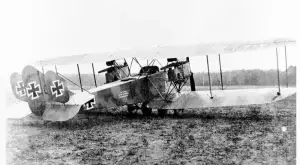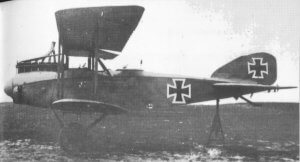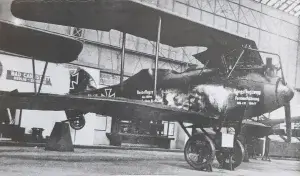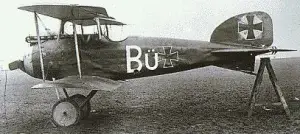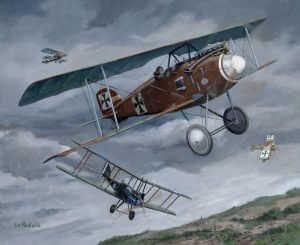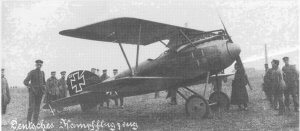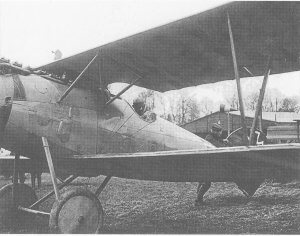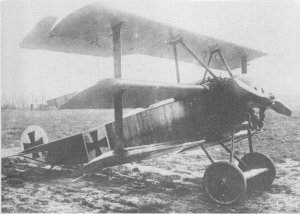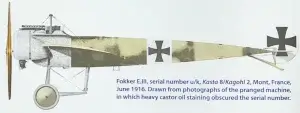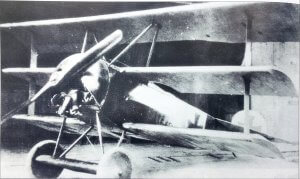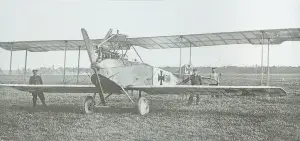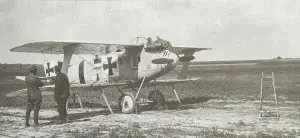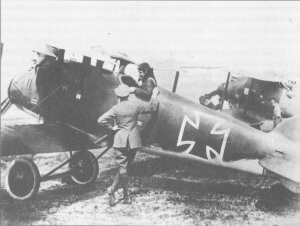A Bomber by Allgemeine Elektrizitäts Gesellschaft.
Engine: 2 × Benz Bz.III 6-cyl. water-cooled in-line piston engine, 112 kW (150 hp) each
Armament: up to 3 × 7.92 mm (.312 in) machine guns
The AEG G.II was a German biplane bomber aircraft of World War I developed from the AEG G.I, with more powerful engines. The G.II was typically armed with three 7.92 mm (.312 in) machine guns and 200 kg (440 lb) of bombs. The bomber suffered stability problems, and many G.IIs were fitted with additional vertical tail surfaces on each side of the fin and rudder to improve flight handling characteristics.[1]
This aircraft was the second assignment of Baron von Richthofen prior to becoming a pilot.
(source: Wikipedia)
Span: 16.2 m (53 ft 1.79 in)
Length: 9.1 m ( 29 ft 10.26 in)
Height: 3.49 m (11 ft 5.4 in)
Wing surface: 59 m² (640 ft²)
Empty weight : 1450 kg (3196 lbs)
Max. weight: 2464 kg (5434 lbs)
Max. speed: 140 km/h (87 Mph)
Ceiling: 3000m (9800 ft)
Endurance: 700 km (434 mi)1.5 m/s (300 ft/min)
Climb rate: 1.5 m/s (300 ft/min)
A Multifunctional by Albatros Flugzeugwerke.
Engine: 1 x Daimler D III piston engine 119.3 kW (160 hp)
Armament: 1 x 7.92 Parabellum machine gun + 1 x 7.92 LMG 08/15 machine gun + 91 kg bombs
Span: 11.69 m (38.3 ft)
Length: 8 m (26.2 ft)
Height: 3.1 m (10 ft)
Wing surface: 36.91 m² (397 ft²)
Empty weight : 851 kg (1876 lbs)
Max. weight: 1353 kg (2983 lbs)
Max. speed: 140 km/h (87 mph)
Ceiling: 3353 m (11.000 ft)
Endurance: 1000 m (3280 ft) in 9 minutes
Climb rate: 1000 m (3280 ft) in 9 minutes
A Shuttle by Albatros Flugzeugwerke.
Engine: 1 × Mercedes D.III Inline piston engine, 118 kW (158 hp)
Armament: 2×7.9mm machine guns
Type used by MvR to travel behind the lines.
Span: 10.4 m (34 ft 1 in)
Length: 8.22 m (27 ft 0 in)
Height: 2.74 m (9 ft 0 in)
Wing surface:
Empty weight : 790 kg (1,742 lb)
Max. weight:
Max. speed: 155 km/h (96 mph, 84 kn)
Ceiling:
Endurance: 385 km (239 mi, 208 nmi)
Climb rate:
A Fighter by Albatros Flugzeugwerke.
Engine: either a 110 kW (150 hp) Benz Bz.III or a 120 kW (160 hp) Mercedes D.III six-cylinder water cooled inline engine
Armament: 1 × forward-firing synchronized 7.92 mm (0.312 in) lMG 08 machine gun
The D.I was designed by Robert Thelen, R. Schubert and Gnädig, as an answer to the latest Allied fighters, such as the Nieuport 11 Bébé and the Airco D.H.2, which had proved superior to the Fokker Eindecker and other early German fighters, and established a general Allied air superiority. It was ordered in June 1916 and introduced into squadron service that August.
The D.I had a semi-monocoque plywood fuselage, consisting of a single-layered outer shell, supported by a minimal internal structure. This was lighter and stronger than the fabric-skinned box-type fuselage then in common use, as well being easier to give an aerodynamically clean shape. At the same time its panelled-plywood skinning, done with mostly four-sided panels of thin plywood over the entire minimal fuselage structure, was less labour-intensive (and therefore less costly to manufacture) than a “true” monocoque structure.The Albatros D.I was powered by either a 110 kW (150 hp) Benz Bz.III or a 120 kW (160 hp) Mercedes D.III six-cylinder water cooled inline engine. The additional power of the Mercedes (Daimler) engine enabled twin fixed Spandau machine-guns to be fitted without any loss in performance.
The D.I had a relatively high wing loading for its time, and was not particularly manoeuvrable. This was compensated by its superior speed and firepower and it quickly proved the best all-round fighter available.
Source: Wikipedia
Span: 8.5 m (27 ft 11 in)
Length: 7.4 m (24 ft 3 in)
Height: 2.95 m (9 ft 8 in)
Wing surface: 22.9 m2 (246 sq ft)
Empty weight : 647 kg (1,426 lb)
Max. weight: 898 kg (1,980 lb)
Max. speed: 175 km/h (109 mph)
Ceiling: 5,000 m (16,000 ft)
Endurance: 1.5 hours2.8 m/s (550 ft/min)
Climb rate: 2.8 m/s (550 ft/min)
A Fighter by Albatros Flugzeugwerke.
Engine: Mercedes D.III, 119 kW, 160 hp
Armament: 2 x 7.92 mm (0.312 in) LMG 08.15 machine-guns
The Fokker E-series fighters were obsolescent by the spring of 1916, and as part of the German effort to find a successor Albatros developed the D I that first flew in August 1916 with a well streamlined plywood-covered fuselage, equal-chord biplane wings and a Benz Bz.III or Mercedes D.III inline engine whose 112 or 119 kW (150 or 160 hp) allowed the installation of two guns without serious degradation of the fighter’s high performance. The type was soon in service, and proved superior in all important respects to current Allied fighters. The sole criticism levelled at the type was the location of the upper wing, which impaired the pilot’s upward field of vision, and in the definitive D.II the wing was lowered, the D.III engine standardized and, in later aircraft, the fuselage ear-type radiators exchanged for a faired radiator in the upper-wing centre section. (source: The International Encyclopedia of Aircraft, Oriole Publishing, 1991)
Span: 8.5 m (27 ft 10.75 in)
Length: 7.4 m (24 ft 3.25 in)
Height:
Wing surface:
Empty weight :
Max. weight: 888 kg (1958 lb)
Max. speed: 175 km/h (109 mph)
Ceiling: 5000 m (16.400 ft)
Endurance: 1.5 hours37 minutes to ceiling
Climb rate: 37 minutes to ceiling
A Fighter by Albatros Flugzeugwerke.
Engine: 1 Mercedes D.IIIa 127 kw (170 hp) or 130kW(175 hp)
Armament: 2 7.92mm LMG 08/15 machinguns
As soon as the D.II was in production, its designer turned to a more advanced version intended to offer considerably improved manoeuvrability. The result was the D.III that retained the fuselage and empennage of the D.II but added a version of the D.III engine with a higher compression ratio for slightly more power, and adopted a new wing cellule without stagger. The wings comprised a longer-span upper wing with raked tips and a narrow-chord lower wing in a sesquiplane arrangement with V-layout interplane struts. At the same time the radiator was shifted from the centre section to the starboard wing so that a bullet puncture would not result in the pilot being scalded. The D.III entered service in the spring of 1917, and was produced in large numbers to become the decisive fighter over the Western Front between that time and the autumn of the same year. (source: The International Encyclopedia of Aircraft, Oriole Publishing, 1991)
Span: 9.05 m(29.6 ft)
Length: 7.33 m (24 ft)
Height:
Wing surface:
Empty weight :
Max. weight: 886 kg (1953 lbs)
Max. speed: 176 km/h (109 mph)
Ceiling:
Endurance: 2 hours
Climb rate:
A Fighter by Albatros Flugzeugwerke.
Engine: 1 Daimler D.IIIa 6-cylindre line engine 149 kW (200 hp)
Armament: 2 7.92mm LMG 08/15 machinguns
In a effort to keep its basic fighter design competitive with the Allied fighters that began to appear during 1917, Albatros developed a much improved version of the D.III with a fuselage of deeper, elliptical cross-section to reduce drag and thus boost performance, a factor in which the larger-diameter propeller spinner played its part. Other changes were further reduction in the height of the upper wing above the fuselage, a revised rudder, a pilot’s headrest that was often removed, and a different aileron control system. The D.V entered service in May 1917, and was soon joined by the D.Va that reverted to the upper wing and aileron control system of the D.III. Very large-scale production of both variants was undertaken, but the design was outmoded and could not match the latest Allied fighters. The lower wing was also weak, and tended to break away in a steep dive. (source: The International Encyclopedia of Aircraft, Oriole Publishing, 1991)
Span: 9.05 m (29.6 ft)
Length: 7.33 m (24 ft)
Height: 2.75 m (9 ft)
Wing surface: 20.86 m² (224.5 ft²)
Empty weight : 680 kg (1499 lbs)
Max. weight: 937 kg (2065 lbs)
Max. speed: 170 km/u (105.6 mph)
Ceiling: 6250 m (20.505 ft)
Endurance: 2 hours (350 km ( 217 mi))
Climb rate:
A Fighter by Fokker Flugzeugwerke.
Engine: 1 x 9-cylindre Oberursel Ur. II rotary engine or 1 x Le Rhône 81 kW (108 hp)
Armament: 2 x 7.92 mm air-cooled LMG 08/15 machine-guns
Perhaps the best known German fighter of World War I because it was flown by such aces as Manfred von Richthofen, the Dr.I was an indifferent performer in all aspects of air combat but climb and agility, in which it possessed almost legendary capability. The Dr.I was inspired by the Sopwith Triplane, but took the triplane formula to extremes in maximizing wing area while minimizing overall span. Designed by Reinhold Platz, the Dr.I had a rotary engine, steel-tube fuselage and virtually cantilever wings of wooden construction with ply skinning over their forward surfaces. The type entered service in August 1917, and 420 were built up to May 1918, by which time its low performance was a distinct liability in the hands of all but the most capable of pilots flying purely defensive sorties. (source: The International Encyclopedia of Aircraft, Oriole Publishing, 1991)
Span: 7.2 m (23.6 ft)
Length: 5.77 m (19 ft)
Height: 2.95 m (9.6 ft)
Wing surface: 18.66 m² (201 ft²)
Empty weight : 430 kg (948 lbs)
Max. weight: 610 kg (1345 lbs)
Max. speed: 185 km/u (115 mph)
Ceiling: 6100 m (20.013 ft)
Endurance: 1.5 hours1000 m (3280 ft)in 2'54"
Climb rate: 1000 m (3280 ft)in 2'54"
A Fighter by Fokker Flugzeugwerke.
Engine: 1 x 9-cylindre air-cooled Oberursel U.1 75 kW (100 hp)
Armament: 1 x 7.9 mm Parabellum or MG 08/15 machine-gun
When it appeared in the late summer of 1915, the Fokker E.I was the world’s first true fighter, for despite its poor performance and indifferent monoplane structure (derived from its M.5k unarmed predecessor) it was armed with a machine-gun enabled to fire directly forward through the propeller disc by the world’s first practical interrupter gear. The E.I (few built) was underpowered, and succeeded by the E.II with greater power (23 built) and then by the definitive E.III (between 120 and 150 built) with the same engine but a number of detail improvements. This was the aircraft of the 1915/16 ‘Fokker Scourge’ in which these poor aircraft prevailed because of their armament and the skill of their pilots. Allied developments prompted the E.IV with two guns and greater power, but this lacked any real agility. (source: The International Encyclopedia of Aircraft, Oriole Publishing, 1991)
Span: 9.5 m (31 ft)
Length: 7.2 m (23.6 ft)
Height: 2.4 m (7.8 ft)
Wing surface: 16 m² (172.3 ft²)
Empty weight : 610 kg (1344.8 lbs)
Max. weight:
Max. speed: 140 km/h (87 mph)
Ceiling: 3500 m (11.483 ft)
Endurance: 1.5 hours200 m (656 ft) / minute
Climb rate: 200 m (656 ft) / minute
A Fighter by Fokker Flugzeugwerke.
Engine:
Armament:
(source: The International Encyclopedia of Aircraft, Oriole Publishing, 1991)
Span:
Length:
Height:
Wing surface:
Empty weight :
Max. weight:
Max. speed:
Ceiling:
Endurance:
Climb rate:
A Fighter by Halberstädter Flugzeugwerke.
Engine: 6-cylindre Mercedes D.II engine 88.3 kW (118.4 hp)
Armament: 1 7.92 mm LMG 08/15 machinegun
The Halberstadt D-series of single-seat fighters was developed from the unarmed B.II reconnaissance two-seater, inheriting that type’s considerable structural strength. The D.I appeared late in 1915 with a single interrupted gun and a powerplant comprising one 75-kW (100 hp) Mercedes D.I inline engine. The production model, of which few were built, was the D.II with the more powerful Mercedes D.II engine and a wing radiator in place of the original nose-mounted unit. These served for a few months from June 1916 before being supplanted by the D.III, which differed mainly in its larger horn-balanced ailerons and as powerplant one 89-kW (120 hp) Argus AS.II inline. A few D.IV’s were produced for Turkey with twin guns and the 112 kW (150 hp) Benz Bz.III, and the D.V of 1917 was a refined type with more streamlined plywood-covered fuselage and the As.II engine. (source: The International Encyclopedia of Aircraft, Oriole Publishing, 1991)
Span: 8.8 m (28.8 ft)
Length: 7.3 m (24 ft)
Height: 2.67 m (8.75 ft)
Wing surface: 23.6 m² (254 ft²)
Empty weight : 520 kg (1146 lbs)
Max. weight: 730 kg (1609 lbs)
Max. speed: 145 km/h (90 mph)
Ceiling: 5974 m (19.600 ft)
Endurance: 2 hours (250 km/155 mi)
Climb rate:
A Reconnaissance/Light Bomber by Luft-Verkehrs-Gesellschaft.
Engine: 1 × Mercedes D.III , 119 kW (160 hp)
Armament: 1 × flexible 7.92 mm (.312 in) Parabellum MG14 machine gun + 1 × fixed, forward-firing 7.92 mm (.312 in) LMG 08/15 machine gun (later production aircraft) + up to 60 kg (130 lb) of light bombs
The C.II was developed from the LVG B.I, with the pilot and observer positions reversed, adding a ring-mounted machine gun to the rear. The increase in weight required a larger engine, the Benz Bz.III. Few C.I’s were built before the C.II was introduced. It incorporated structural improvements and a more powerful engine. (source: wikipedia)
Span: 12.85 m (42 ft 2 in)
Length: 8.10 m (26 ft 7 in)
Height: 2.93 m (9 ft 7.25 in)
Wing surface: 37.60 m2 (404.74 sq ft)
Empty weight : 845 kg (1,863 lb)
Max. weight: 1,405 kg (3,097 lb)
Max. speed: 130 km/h (81 mph)
Ceiling: 4000 m (13125 ft)
Endurance: 4 hours
Climb rate:
A Reconnaissance by Roland (LFG).
Engine: 1 × Mercedes D.III 6-cylinder water-cooled in-line piston engine, 120 kW (160 hp)
Armament: 1x 7.92 mm (0.312 in) Parabellum MG14 machine gun on a ring mounting in rear cockpit, + 1x forward-firing synchronized 7.92 mm (0.312 in) Maschinengewehr 08 "Spandau" machine gun
The C.II had much lower drag than comparable aircraft of its time. It featured a monocoque fuselage built with an outer skin of two layers of thin plywood strips at an angle to each other (known as a Wickelrumpf, or “wrapped body” design).[1] This had both lower drag and better strength per weight than typical of the time, but it was relatively slow and expensive to build. (This approach was further developed in the de Havilland Mosquito of World War II.) The deep fuselage completely filled the vertical gap between the wing panel center sections, eliminating any need for cabane struts commonly used in biplanes, and gave the aircraft its “whale” nickname. Struts and wires were reduced, without suffering the weight penalty of cantilever wings, like those used on the pioneering all-metal Junkers J 1 of late 1915. There was even some attempt to fair the wings into the fuselage, to eliminate dead air space, a feature prominently missing from the Schneider Trophy contestants of the following decade. The engineer in charge of the design was Tantzen, who was a student of Ludwig Prandtl, the founder of mathematical aerodynamics and the one to introduce the concept of boundary layer
The C.II entered service in the spring of 1916. Operationally, handling was reported as difficult but performance was relatively good. Due to the crew positions with eyes above the upper wing, upward visibility was excellent, but downward visibility was poor. It was also used in a fighter escort role and had a crew of two, pilot and observer/gunner.
Because of its speed, when it was first introduced, few enemy aircraft could catch it level flight. A notable exception was the Nieuport 17 C.1, which was introduced at almost the same time, and which was several miles per hour faster. Because of the lack of downward visibility, it was best attacked by diving below and coming up at it.[2]
Albert Ball, whose first victim was a C.II, said in the latter half of 1916 that it was “the best German machine now”.
(source: wikipedia)
Span: 10.3 m (33 ft 10 in)
Length: 7.7 m (25 ft 3 in)
Height: 2.9 m (9 ft 6 in)
Wing surface: 26 m2 (280 sq ft)
Empty weight : 764 kg (1,684 lb)
Max. weight: 1,284 kg (2,831 lb)
Max. speed: 165 km/h (103 mph)
Ceiling: 4000 m (13000 ft)
Endurance: 4-5 hours dependent on fuel load2000 m (6600 ft) in 12 minutes
Climb rate: 2000 m (6600 ft) in 12 minutes
A Fighter by Roland (LFG).
Engine: 1 x Argus As.III 134 kW (180 hp)
Armament: 2 x 7.92 LMG 08/15 machine guns
The D.I was in essence the C.II two-seater scaled down as a single-seat fighter. The type was nicknamed Haifisch (shark) for its deep fuselage with the slightly swept upper wing attached directly to it. The D.I first flew in July 1916, and was produced in small numbers. The definitive version was the D.II, which retained the same 119 kW (160 hp) Mercedes D.III engine but featured a number of drag-reducing revisions as well as a modified empennage. The D.II began to enter service early in 1917, and was complemented by the D.IIa with a more powerful engine. The D.II and D.IIa were not popular in service, pilots complaining about lack of vision and heavy controls. The D.III introduced a revised and shallower fuselage over which the upper-wing centre section was supported on cabane struts, but only a few were built. The single D.V prototype had a more refined fuselage structure. (source: The International Encyclopedia of Aircraft, Oriole Publishing, 1991)
Span: 8.94 m (29 ft 4 in)
Length: 6.93 m (22 ft 9 in)
Height:
Wing surface:
Empty weight :
Max. weight: 795 kg (1753 lbs)
Max. speed: 181 km/h (112.5 mph)
Ceiling:
Endurance: 2 hours
Climb rate:
